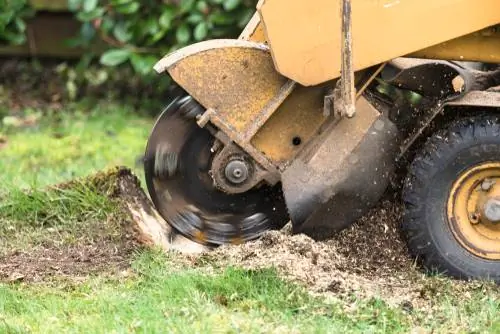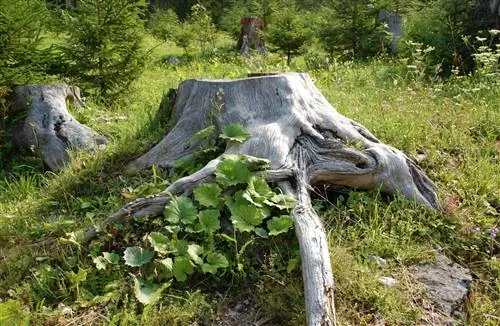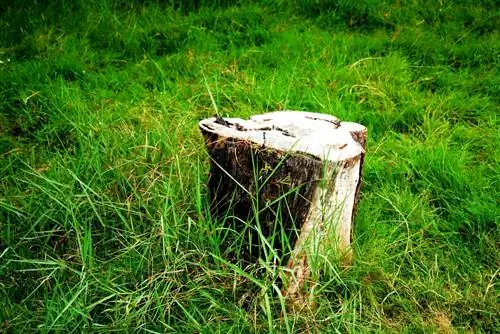- Author admin [email protected].
- Public 2023-12-16 16:46.
- Last modified 2025-06-01 06:02.
It happens that a tree has to be felled due to declining vitality or a lack of space in the garden. What remains is a tree stump, which is often an eyesore. There are various ways to remove the remains.
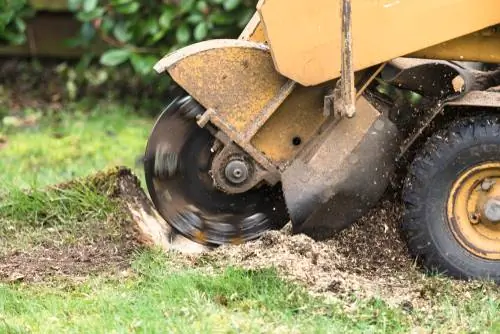
How do I remove a tree stump?
To remove a tree stump, you can dig it up, treat it chemically, allow it to decompose biologically, or hire a professional company. Mechanical tools such as a chainsaw or stump grinder can make the process easier. Alternatively, natural substances such as yeast or compost can be used.
What methods are suitable for removal?
The most effective solution is to dig up the old tree stump by hand. If you don't have a mini excavator or a winch, you're faced with a tedious task. Shallow-rooted trees can be exposed with relatively little effort. If it's a deep-rooted tree like fir trees, it usually takes several hours. The job will be made a little easier if you dig up just the top part of the root system and cut through the roots with a chainsaw.
You can invest some money and hire a landscaping company to come with a stump grinder. But it can also be done without digging. You can effectively kill tree stumps using chemicals. However, the products are harmful to the environment and are not suitable for use in your own garden. You can also naturally accelerate the rotting process of the tree stump on site using biological means.
| Advantage | Disadvantage | |
|---|---|---|
| by hand | hardly any root residues in the ground | laborious, tools necessary |
| with chemistry | efficient and fast | harmful to the environment |
| organic | harmless for nature and he alth | long process |
| Instruct a company | done quickly | expensive |
Chemical Agents
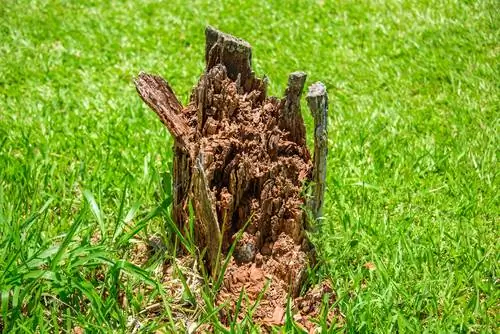
Application of potassium nitrate causes the wood to decompose more quickly
Potassium nitrate, which is scattered into the wood as granules, serves as a decomposition accelerator. Depending on the size of the tree and the type of wood, the decomposition period can take between three and twelve months. Compared to natural rotting, chemical agents save a lot of time. Since these products have a negative impact on people and the environment, you should consider alternatives. Children and pets should stay away from the tree stump after treatment. Damage to he alth can occur if inhaled.
How to use the remedy:
- Drilling holes in the tree stump
- Sprinkle powder into the holes
- Observe tree stump
- If it is soft enough, the wood can be chopped
- Repeat application if necessary
Mechanical aids
If you don't have an excavator at hand and want to remove the tree stump without a milling machine, patience and muscle strength are required. Smaller stumps can be removed using manual methods. For large root systems, consider alternatives. After you get the stump out of the ground, you should fill the hole with sawdust or clay. The material will settle over the coming weeks, so you will need to add fresh substrate regularly.
| Trees | Method | ||||
|---|---|---|---|---|---|
| Shallow-rooted | Spruce, birch, chestnut, hazelnut, cherry | Dig up and cut roots | |||
| Deeproots | Oak, walnut, fir, pine | work with a stump grinder | |||
| Heartroots | Larch, hornbeam, maple, gingko | rinse with a high-pressure cleaner and remove with a jack |
milling machine
Tree stump grinders are ideal for removing root systems that grow to a depth of 30 centimeters. These can be rented from hardware stores. Stump grinders work hydraulically and shred tree stumps and roots by rotating a blade disc. The device is placed over the tree stump so that the cutting blades gradually mill away the wood and process it into small pieces. Finally, the remaining wood is removed. You can reuse the substrate as mulch.
With axe, shovel and jack
This method is only suitable for shallow-rooted trees, as you cannot completely expose the root system of deep-rooted plants. Use a shovel to dig up the large roots and cut them. Depending on the strength of the roots, you will need an ax, pruning shears or a root saw to cut through.
With a special root hoe (€108.00 on Amazon) you can more easily tear the underground runners out of the ground. After all the roots have been cut, you can remove the stump from the hole. It's easier if you place a jack in the middle under the stump and lever it out.
Winch or hand rope hoist
With these tools you can easily remove stumps from deeper-rooted trees. Here too, you first have to expose some roots so that the tree stump loses its grip.
The winch is placed around a tree root and attached to a stable object. This could be a nearby tree. The rope is then put under tension so that the tree stump moves slowly. Continue working on the stump with an ax and spade. Expose roots and cut them until you can pull the root system out of the soil.
Facts about the pulley:
- Steel cable with at least one ton of pulling force required
- Cable hoists with two tons of pulling force are common
- Lever mechanism makes operation easier
High-pressure cleaner
A high-pressure cleaner is ideal for exposing roots and easily loosening heavily overgrown tree stumps. This method is particularly recommended for large trees with particularly tight roots. However, you will need large amounts of water to wash away the soil. In addition, mud forms, which you then have to remove with a shovel and wheelbarrow. Use a winch or jack to get the tree trunk out of the hole.
Fertilizer
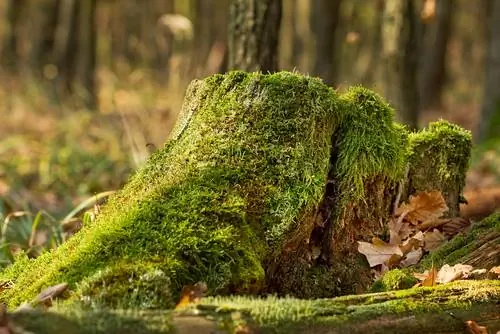
Old tree stumps are a great fertilizer for the soil
In the forest, tree stumps are left standing so that nature can do its work. Moss, bacteria and fungi naturally remove the tree stump. However, this process takes up to ten years. You can help and accelerate the decomposition process with fertilizers. With regular use, the stump will decompose after a year. Drill enough holes in the tree stump and fill them with the appropriate substances.
Suitable fertilizers:
- Compost: Microorganisms colonize the wood
- Limetic nitrogen: supplies microorganisms with important nutrients
- Yeast: accelerates decomposition and produces heat
Fire
Burning out old root systems only works superficially, because fire needs oxygen and therefore cannot penetrate to the roots. Nevertheless, the tree stump is severely damaged and the underground root remains are gradually decomposed by microorganisms. However, wood residues that are covered with a layer of ash rot poorly.
Procedure
Saw several slits in the tree stump to create a depression. Fill the hollow with the sawn out wood scraps and layer paper between the wood. This way you can easily start the fire. Pay attention to the wind direction and repeat the burnout if necessary so that the stump does not burn on one side. Alternatively, you can arrange larger logs around a taller tree stump so that it is in the center of the fire.

What you should avoid
Avoid the so-called root-ex method, in which mixtures of s altpeter or sodium nitrate and petroleum are burned. The substances cause a smoldering fire. If used incorrectly, petroleum can contaminate the soil. In addition, this method creates a lot of smoke and endangers not only the environment but also he alth. Alternatives with diesel or fuel paste are also not recommended.
Caution is advised:
- Observe municipal regulations
- do not use accelerants
- pay attention to surrounding vegetation
Kill with s alt
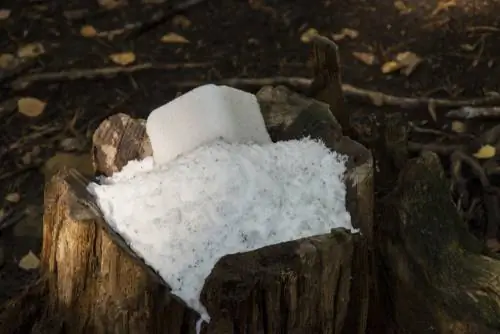
S alt helps kill the tree, but is not good for the soil in large quantities
If the tree stump is still alive and tends to sprout, you can kill it with s alt. Table s alt is unsuitable for this method as it not only damages the tree stump and roots, but also endangers the surrounding soil.
Drill holes 20 to 30 centimeters deep in the stump, making sure they are evenly distributed. Fill the holes with s alt, leaving some room at the top. Then drip candle wax into the hole to seal it. Cover the stump with an opaque plastic sheet to help the stump die faster.
Suitable s alts:
- Rock S alt
- Epsom S alt
- Epsomite
Tip
Use pure s alt without additives, as these can endanger soil organisms.
Ineffective and unsuitable methods
There are always adventurous tricks for removing tree stumps that you should avoid. Some measures damage the soil and the organisms living in it.
Acid
Chemical chemicals such as hydrochloric acid are highly hazardous to the environment because they denature proteins and kill microorganisms. Such agents not only ensure that the tree stump is killed, but also prevent plant growth in the future.
Copper sulfate
Copper sulfate is a substance used to kill bacteria and is said to speed up the decaying process of tree stumps. The duration of action is between three and twelve months. Since copper sulfate has a highly toxic effect on microorganisms and poses a major threat to water, it is not recommended to use it in the garden.
Excursus
Blue Water Nails
Blue nails are considered secret weapons for removing a troublesome tree. Inside the tubes there is a solution of blue color consisting of copper sulfate and water, into which a copper nail has been inserted. This combination is intended to maximize the toxic effects of copper. The impact on the tree is highly controversial. What is certain, however, is that the solution is harmful to the environment and can endanger water bodies.
Coppernail
Copper nails injure the tree stump, but do not cause it to die completely. The amounts of copper are too small to damage the wood. In the 1970s, several nails made of copper, lead, iron and brass were driven into trees. The wood reacted to copper and changed color at the wound. However, the trees didn't die as a result.
Alternative: tree stump as a garden decoration
Unearthed tree roots do not necessarily have to be disposed of or burned. They are interesting decorative elements in shade beds or heather gardens. If you don't have the opportunity to get the tree stump out of the ground, you can also integrate it decoratively into the garden.
How to use the tree stump:
- Birdbath stand
- Location for planted flower bowls
- Trail for climbing plants
- Feeding place
A tree stump can be used decoratively and beautify the garden.
Planting a tree stump
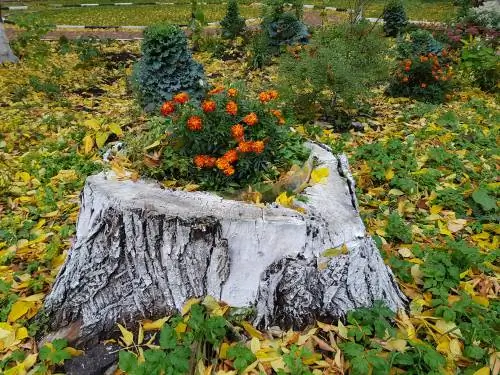
A planted tree stump looks pretty and gives it a second life
Hollow out the tree stump with a hammer and chisel and seal the wood so that no moisture can penetrate later. Tree resin or linseed oil is suitable for this. You can then fill the cavity with soil and insert the plants you want.
Tip
Many plants colonize rotting wood. If you forgo sealing, you can plant the tree stump with pubic flowers or wild orchids.
Frequently asked questions
Why does a tree stump need to be removed?
The root system of deciduous trees lives on after they are felled, so new shoots emerge. The roots also continue to grow, putting supply and drainage pipes or old masonry at risk. The remaining roots are also capable of lifting paving stones. The root system of shallow-rooted trees takes up space, so you cannot create a bed or sow lawn in this area.
Is there anything I have to pay attention to if I want to remove a tree stump?
You do not need a permit when removing a tree stump. However, there are regulations regarding tree removal. In Germany, trees are not allowed to be felled between March 1st and September 30th because birds breed during this time. There is no set time period for tree stump removal. However, you should weigh the methods against each other. It is not allowed to light a fire in the garden everywhere. Check with your municipality as each federal state has its own regulations.
How can I remove my lilac tree stump?
Lilac has a strong tendency to sprout roots, which is why you have to remove the roots from the ground as completely as possible after felling. When felling, leave 100 to 150 centimeters of the trunk standing and then cut off the root area with a spade. This should be as large as the former crown diameter. You can then loosen the root ball with a digging fork. Move the trunk in all directions to loosen the roots in the substrate. For large trees you have to cut the roots. You can then pull the tree stump out of the ground.
How do I remove a willow tree stump?
Saw above-ground trunks to about 100 centimeters above the ground. Then dig up the roots so that the main roots are exposed. The root strands are completely severed. You can then pull the tree stump out of the ground using a hand rope.
Have the tree stump removed by a company - How much does it cost?
On average, you can expect to spend two hours working, although this depends on the size of the tree stump. The companies also charge travel costs, which is why you should hire companies in your area. Also keep in mind that disposal by a company costs between 50 and 80 euros. There are no disposal costs when working with a tiller because you can use the material as mulch. Get quotes from different companies to get the cheapest price.
Average labor cost per hour:
- Excavation with an excavator: 70 to 80 euros
- Removal with the stump grinder: 90 to 110 euros

